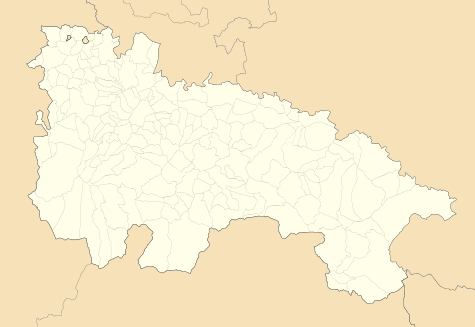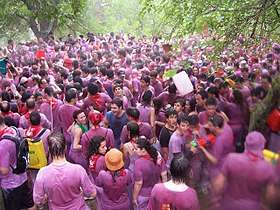Haro, La Rioja
Haro (Spanish pronunciation: [ˈaɾo]) is a town and municipality in the northwest of La Rioja province in northern Spain. It produces red wine, and hosts the annual Haro Wine Festival. Its architectural heritage includes the plateresque main entrance of the Church of Santo Tomás, the work of Felipe Vigarny, numerous palaces, and the old town, which was declared a Historic-Artistic Site in 1975.
Haro | |
|---|---|
 | |
.svg.png) Seal | |
 Haro Location of Haro within La Rioja  Haro Haro (Spain) | |
| Coordinates: 42°35′N 2°51′W | |
| Country | |
| Autonomous community | |
| Comarca | Haro |
| Government | |
| • Mayor | Laura Rivado Casas (PSOE) |
| Area | |
| • Total | 40.53 km2 (15.65 sq mi) |
| Elevation | 479 m (1,572 ft) |
| Population (2018)[1] | |
| • Total | 11,309 |
| • Density | 280/km2 (720/sq mi) |
| Demonym(s) | harense; jarrero, ra |
| Time zone | UTC+1 (CET) |
| • Summer (DST) | UTC+2 (CET) |
| Website | www |
Haro was the first town in Spain to have electric street lighting.
History
There are several theories about the founding of Haro, though the most realistic theory is that of Domingo Hergueta, who argued that before the town, there was a lighthouse (Spanish: faro) near the village of Cerro de la Mota which illuminated the mouth of the Ebro river. The town was named for the lighthouse, and Faro later evolved into Haro.
During the Roman rule of Hispania, a fort called Castrum Bibilium was built in the cliffs of Bibilio. The first mention of Haro dates back to the year 1040, in a document of king García Sánchez III of Navarre"el de Nájera". Alfonso VI of León and Castile entrusted the tenencia to Diego López I de Haro after the death of Count García Ordóñez and the first of the lords of Biscay to attach the name of this town to his patronymic was Diego's son, Lope Díaz I de Haro.


Notable people
- Manuel Risco
- Manuel Bartolomé Cossío
- Lucrecia Arana (1871-1927), singer
- Eduardo Fajardo
- Luis de la Fuente Castillo
- Ana Ibáñez Llorente

See also
- House of Haro
- Tempranillo
- Rioja wine
- Municipal Register of Spain 2018. National Statistics Institute.